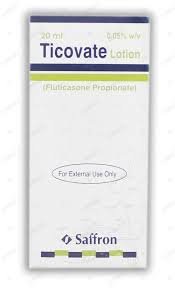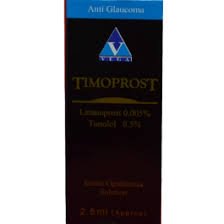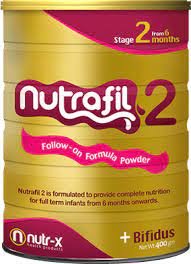The mechanism of the anti-inflammatory activity of the topical steroids, in general, is unclear. However, corticosteroids are thought to act by the induction of phospholipase A2 inhibitory proteins, collectively called lipocortins. It is postulated that these proteins control the biosynthesis of potent mediators of inflammation such as prostaglandins and leukotrienes by inhibiting the release of their common precursor, arachidonic acid. Arachidonic acid is released from membrane phospholipids by phospholipase A2. Fluticasone propionate is lipophilic and has a strong affinity for the glucocorticoid receptor. It has weak affinity for the progesterone receptor, and virtually no affinity for the mineralocorticoid, estrogen, or androgen receptors. The therapeutic potency of glucocorticoids is related to the half-life of the glucocorticoid-receptor complex. The half-life of the fluticasone propionate-glucocorticoid receptor complex is approximately 10 hours.
TICOVATE LOTION
₨380.00
Description
Reviews (0)
Be the first to review “TICOVATE LOTION” Cancel reply
Shipping & Delivery
MAECENAS IACULIS
Vestibulum curae torquent diam diam commodo parturient penatibus nunc dui adipiscing convallis bulum parturient suspendisse parturient a.Parturient in parturient scelerisque nibh lectus quam a natoque adipiscing a vestibulum hendrerit et pharetra fames nunc natoque dui.
ADIPISCING CONVALLIS BULUM
- Vestibulum penatibus nunc dui adipiscing convallis bulum parturient suspendisse.
- Abitur parturient praesent lectus quam a natoque adipiscing a vestibulum hendre.
- Diam parturient dictumst parturient scelerisque nibh lectus.
Scelerisque adipiscing bibendum sem vestibulum et in a a a purus lectus faucibus lobortis tincidunt purus lectus nisl class eros.Condimentum a et ullamcorper dictumst mus et tristique elementum nam inceptos hac parturient scelerisque vestibulum amet elit ut volutpat.
Related products
Azomax 500mg tablet
₨498.00
BF 1 400G
₨2,530.00
<h6 style=""text-align: left""><span role=""tooltip""><span class=""c5aZPb"" role=""button"" data-enable-toggle-animation=""true"" data-extra-container-classes=""ZLo7Eb"" data-hover-hide-delay=""1000"" data-hover-open-delay=""500"" data-send-open-event=""true"" data-theme=""0"" data-width=""250"" data-ved=""2ahUKEwj8142nuMiEAxWFVKQEHV16AHoQmpgGegQIFBAD""><span class=""JPfdse"" data-bubble-link="""" data-segment-text=""Morinaga"">Morinaga</span></span></span> BF-1 is <b>an infant formula
F Lac
₨2,488.00
Fabimilk 1 1400G
₨2,200.00
Glucerna 400G
₨3,000.00
Namlac 3
₨2,240.00
Nutrafil 2
₨2,483.00
Pediasure 400G
₨2,600.00












Reviews
There are no reviews yet.